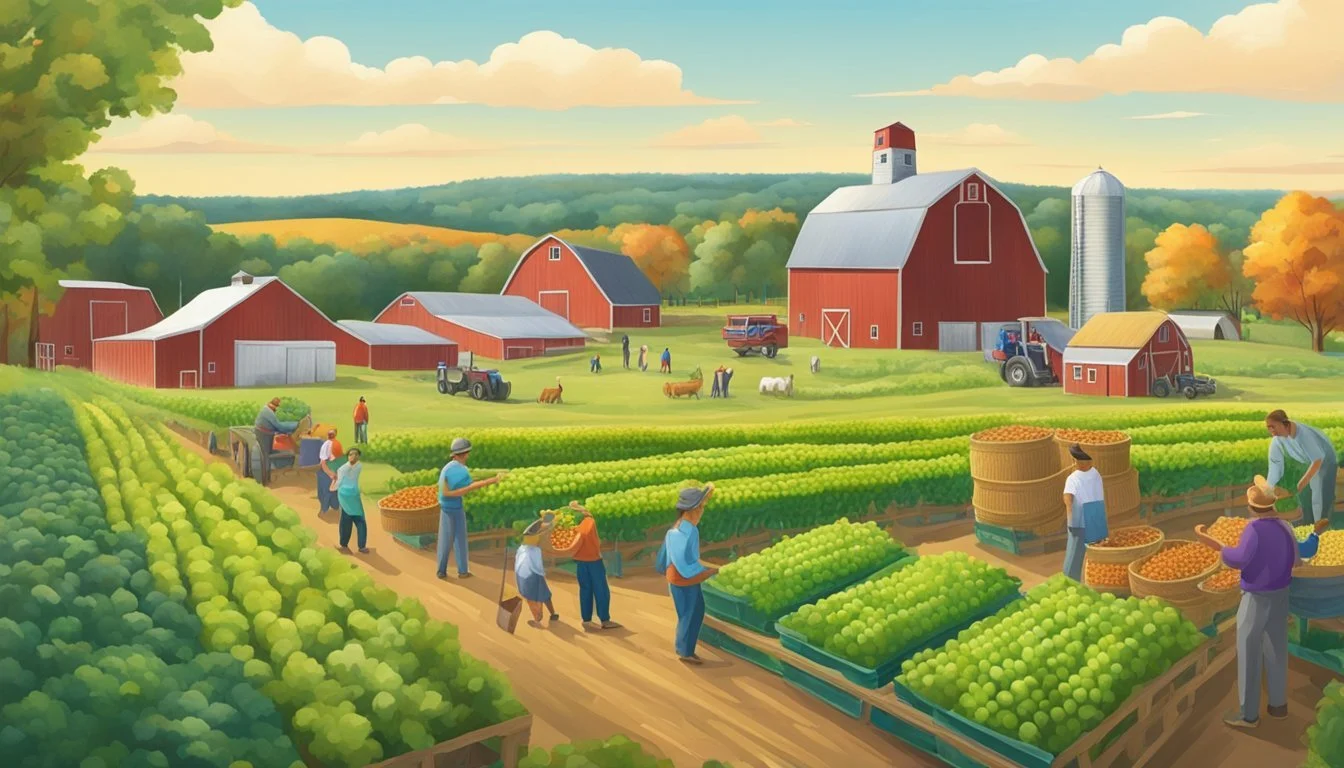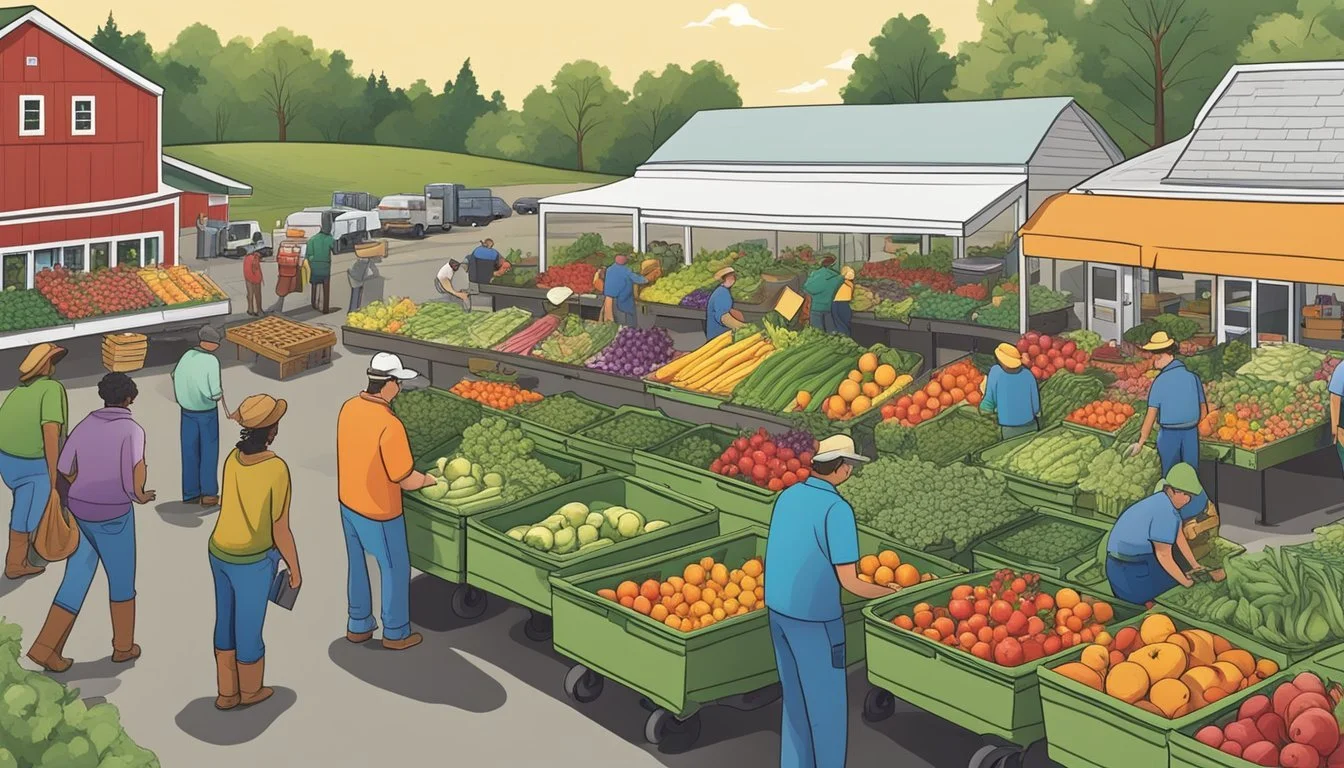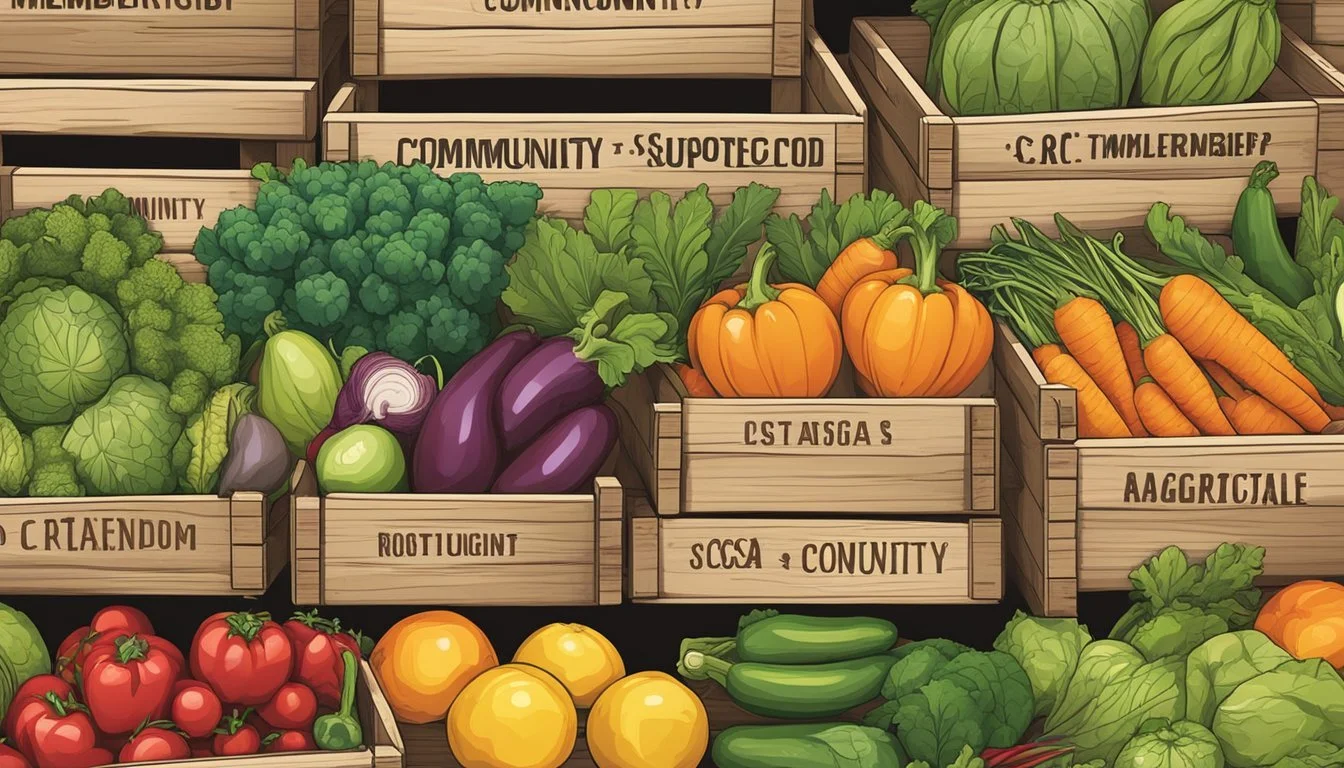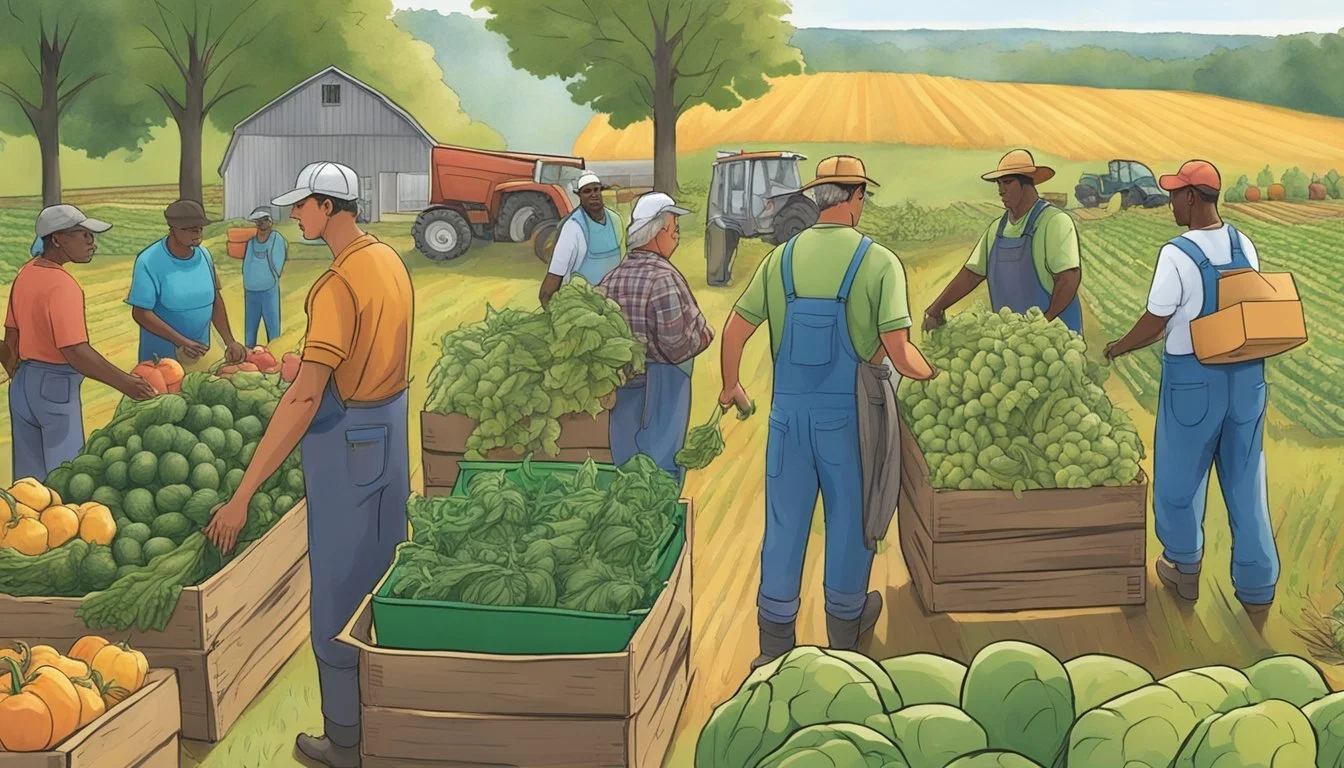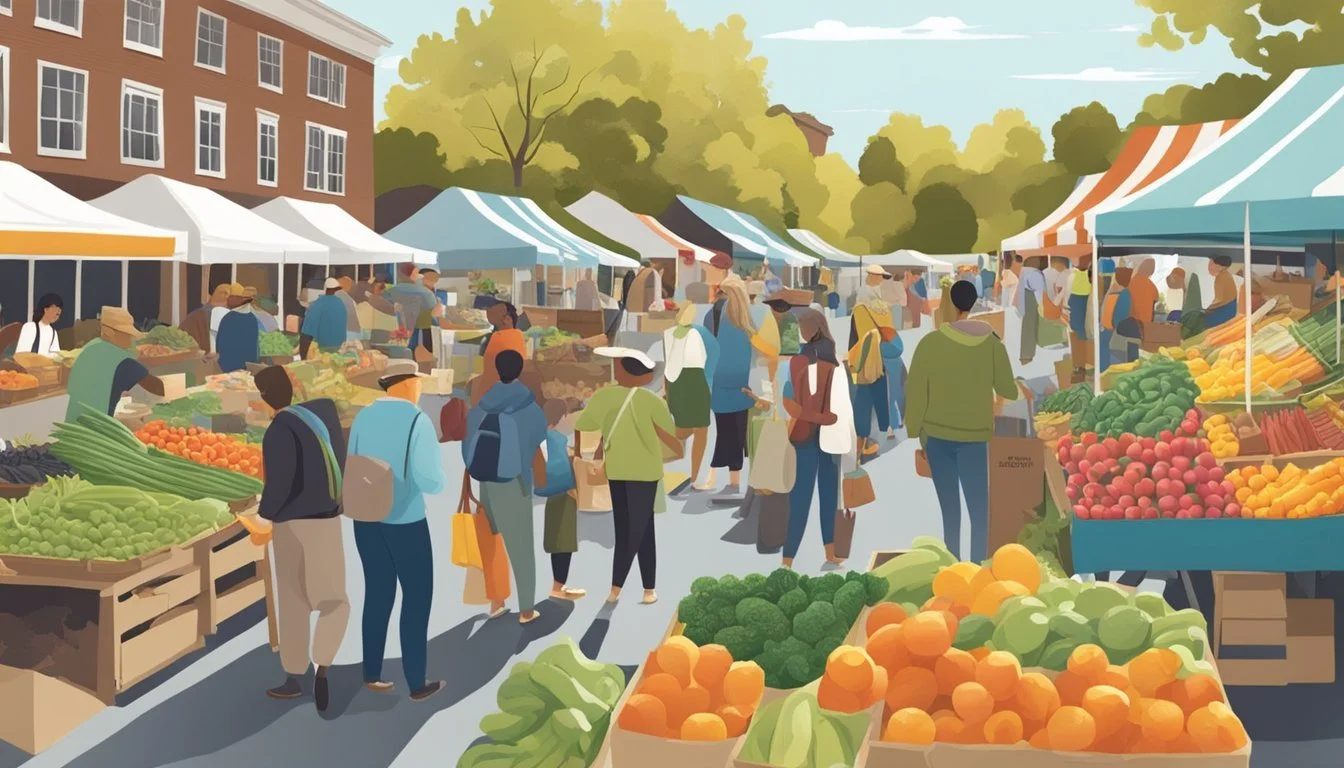Community Supported Agriculture (CSA) in Connecticut
A Guide to Local Farm Partnerships
Community Supported Agriculture (CSA) represents a food system that strengthens the connection between Connecticut farmers and consumers. In this model, consumers buy shares of a farm's expected harvest, providing local farms with upfront revenue. These shares often manifest as weekly deliveries or pickups of fresh produce, dairy products, meats, and other farm goods throughout the farming season.
In Connecticut, CSAs are integral to supporting the local agriculture economy and provide consumers with the freshest seasonal produce while fostering community engagement. Amid challenges such as the COVID-19 pandemic, CSA programs have demonstrated resilience, ensuring a steady food supply chain and mitigating some of the market uncertainties faced by farmers.
The state's commitment to these programs is evident through initiatives like CT NOFA's Farm Share Program, which assists individuals in need of financial support to access CSA shares. Moreover, the Connecticut Department of Agriculture advocates for the benefits of CSAs during National CSA Week and throughout the year, encouraging consumers to participate in this sustainable food practice.
History of CSA in Connecticut
Community Supported Agriculture (CSA) has taken root in Connecticut as a sustainable approach towards agriculture and local food security. Connecticut's CSA model ensures a steady relationship between local farmers and consumers, strengthening the state's agricultural framework.
In the 1980s, pioneers in the CSA movement, such as Indian Line Farm in Massachusetts and Temple-Wilton Community Farm in New Hampshire, influenced the inception of similar initiatives in Connecticut. These farms contributed significantly to the CSA's popularity in the United States, having been founded by Europeans versed in the CSA concept.
Connecticut's farms began adopting the CSA model, establishing a food production system where consumers financially support a farm by purchasing shares of produce in advance. This upfront investment offsets the financial risk for farmers and offers consumers a season’s worth of fresh, local harvests.
Benefits for Consumers Benefits for Farmers Guaranteed fresh produce Secure early-season capital Strengthened connection to the farm Reduced marketing costs Education on sustainable agriculture Better crop planning
Recent years have seen a steady increase in the number of CSA programs across Connecticut. These CSAs are instrumental in promoting CT Grown produce, indicating not just a market trend, but a cultural shift towards community-engaged agriculture. Programs such as CT NOFA's Farm Share further facilitate the expansion of CSAs in Connecticut by making shares more affordable and increasing accessibility to fresh, organic produce for all residents, including those in need of financial assistance.
CSA Benefits
Community Supported Agriculture (CSA) in Connecticut offers tangible benefits that span environmental, economic, and health domains. By joining a CSA, individuals directly contribute to local sustainability efforts, bolster the state's agricultural economy, and gain access to fresh and nutritious produce.
Environmental Impact
Connecticut's CSA programs are foundational to fostering sustainable agricultural practices. They reduce the need for long-distance food transportation, thus lowering carbon emissions. By supporting farms that often follow organic or environmentally conscious farming methods, CSA members indirectly contribute to soil health and biodiversity in their community.
Economic Benefits
From an economic standpoint, CSA programs provide stability for Connecticut farmers. Consumers invest in shares of a farm's harvest upfront, which offers farmers a more predictable income and helps cover the initial costs of the growing season. This financial model is supportive of small and medium-sized farms which are core to Connecticut's agricultural sector.
Health and Nutrition
CSAs champion health and nutrition by giving individuals direct access to fresh, seasonal produce. The closer a product is from farm to table, the richer it is in nutrients. Connecticut residents who participate in CSA programs often enjoy a diverse arrange of farm products, which encourages a balanced and healthful diet. Moreover, by regularly consuming food from CSAs, individuals can better align their eating habits with the seasons, optimizing the nutritional value of their meals.
Overall, embracing CSA models encourages a thriving, health-conscious, and environmentally aware Connecticut community.
How CSAs Work
Community Supported Agriculture (CSA) represents a partnership between the farmers and consumers in Connecticut. In this model, individuals purchase subscriptions, or shares, from local farms, ensuring that they receive a portion of the harvest throughout the farming season.
Subscription Models
There are two primary subscription models for CSAs in Connecticut. Participants can opt for a Full Share, which generally runs for about 20 weeks from June through October, or a Half Share, which lasts for around 10 weeks during the summer months. Prices can vary, with a typical full share costing around $650 and a half share at approximately $325. Subscribers prepay for their shares, which provides them with a regular supply of fresh produce and other farm products.
Community Involvement
Community Involvement is at the heart of the CSA concept. Subscribers are not just buying food; they are forming a relationship with the farm, actively supporting local agriculture, and sharing the risks and rewards of food production. Many CSA programs in Connecticut also offer group delivery options, where shares can be delivered to a single destination site for a group of 20 or more members within a certain distance from the farm.
Farmers' Commitment
Farmers are committed to providing fresh, high-quality produce and other farm products to their CSA members. They plan their production cycles based on the subscriptions they receive, often offering a diverse range of vegetables, fruits, dairy products, meats, and sometimes even value-added products like honey. CSA members typically pick up their shares at designated pickup locations on the farm or at another agreed-upon spot on a weekly or bi-weekly basis.
The CSA model not only ensures a steady market for the farmers' harvest but also integrates Community Involvement by allowing consumers to actively participate in their local food system. Additionally, some organizations in Connecticut, such as the Farm Share Program, offer financial aid to ensure that CSA shares are accessible to individuals in need, while still ensuring full payment to the farmers.
Membership Details
Community Supported Agriculture (CSA) in Connecticut offers a mutual relationship between consumers and local farms, where members pay upfront for a seasonal share of the harvest, ensuring consistent financial support for the farmers and fresh produce for the consumers.
Types of Shares
CSAs typically provide a variety of share sizes to cater to different household needs. The most common types are:
Full Share: Suitable for families or those who consume more produce.
Half Share: Ideal for smaller households or those new to the CSA model.
Quarter Share: Often offered by some farms for individuals or those with limited space.
Members can expect a diverse selection of fruits, vegetables, eggs, and often dairy products, depending on the farm's offerings.
Cost and Payment
The cost of CSA shares in Connecticut varies:
A full share might be priced around $650 for a 20-week period.
A half share could be approximately $325 for 10 weeks.
Additional costs, like sales taxes or signup fees, may apply but are often included in the share price. Many CSAs offer payment plans to help spread out the expense, and some provide financial assistance schemes to make shares accessible to a wider community.
Picking up the Produce
Members collect their shares from designated pickup locations, which are typically at the farm or local markets. Some farms offer:
Group delivery for a certain number of shares to a single destination site.
Specific weekly pickup days and time frames to ensure the produce is as fresh as possible.
By understanding these details, consumers can engage in CSA memberships that support both their dietary preferences and local Connecticut farmers effectively.
Types of Products Offered
Community Supported Agriculture (CSA) programs in Connecticut offer a diverse range of farm-fresh products, including a variety of produce, meats, dairy, and other unique farm offerings.
Vegetable and Fruit Varieties
CSA shares in Connecticut typically include a wide array of vegetables and fruits. Consumers can expect to receive staples such as:
Leafy greens: lettuce, spinach, and kale
Root vegetables: carrots, beets, and onions
Fruit: a selection of apples, berries, and possibly even exotic offerings dependent on the farm
Seasonal favorites include sweet corn, pumpkins, and various types of squash
Meat and Dairy Options
Meat and dairy are significant components of many CSAs. Customers may find:
A range of meats: including beef, pork, poultry, and sometimes lamb or goat
Fresh dairy products: such as milk, cheese, and butter
Farm-fresh eggs are often available as part of the CSA share or as an add-on
Other Farm Products
In addition to traditional produce and animal products, some CSAs offer:
Honey: locally sourced from the farm's own beehives
Maple syrup: a sweet addition from farms with sugar maples
Additional crafted goods like jams, pickles, and baked items may also be included
Choosing a CSA
When selecting a Community Supported Agriculture program in Connecticut, one must consider the diversity of options, the convenience of pickup locations, and the timing of seasonal availability to ensure a rewarding experience.
CSA Diversity and Options
Connecticut offers an array of CSA programs that cater to different consumer needs. From traditional vegetable shares to include dairy products, meats, and bread, the diversity among CSAs allows consumers to support local farmers while receiving fresh, CT Grown produce. For instance, CT NOFA plays a significant role in connecting individuals with various CSA options that suit different lifestyles and preferences.
Vegetable Shares: A variety of fresh vegetables grown by local farmers.
Extended Options: Addition of dairy, meat, or artisanal products.
Strategies for choosing include looking at the farm's produce variety, organic certifications, and additional offerings such as events for members.
Location Considerations
The convenience of pickup locations is a crucial factor in the decision-making process. Many Connecticut farms offer on-site pickups, while others provide multiple locations or even home delivery services to meet the needs of their members. One should ascertain the most convenient pickup point to ensure seamless collection throughout the harvest season.
On-Site Pickup: Directly from the farm.
Off-Site Pickup: Locations such as farmers' markets or centralized community spots.
Seasonal Availability
In Connecticut, the main harvest season typically runs during the summer months, which is when the majority of CSA programs are in full swing. However, some farms may offer year-round shares or special winter CSAs that provide goods like storage crops, greenhouse-grown produce, or value-added products. It's important to consider when the produce you desire is available and align that with the CSA's offered schedule.
Summer CSA: Abundant variety of produce during peak growing season.
Winter CSA: Storage crops and greenhouse-grown items.
Year-Round CSA: Offers continuous supply throughout all seasons.
Consumers should closely examine the duration and timing of CSA availability when choosing their ideal share to match their household needs.
Connecticut CSA Directory
Community Supported Agriculture (CSA) connects consumers directly with farms in Connecticut, providing an opportunity to support local farmers while receiving fresh, seasonal produce.
Local CSA Farms
In Connecticut, numerous local farms offer CSA shares to residents. Notable among them is Lapsley Orchard in Pomfret, a choice for many seeking fresh, locally-sourced fruits and vegetables. They, along with other farms throughout the state, such as those near Newtown and Shelton, enable residents to purchase a portion of the season's harvest upfront. This variety of participating farms ensures that people across different counties have access to fresh produce that supports local agriculture.
County Farm Name Location Notable Produce Windham Lapsley Orchard Pomfret, CT Fruits, vegetables Fairfield Farm Name 2 Shelton, CT Farmers' choice ... ... ... ...
CSA Programs and Events
Apart from individual farm shares, Connecticut also hosts CSA programs and events designed to bolster the ties between local farmers and the community. For example, the CT NOFA Farm Share program aids residents in need by reducing the cost of CSA shares, promoting food equity and supporting organic farms. Meanwhile, events like National CSA Week, which is highlighted by the Connecticut Department of Agriculture, encourage consumers to become CSA members and deepen the consumer-farmer relationship. These programs and events not only contribute to the economic stability of farms but also ensure the ongoing provision of nutritious, locally-sourced food to the community.
Support and Resources
Community Supported Agriculture (CSA) programs in Connecticut thrive with an array of support and resources aimed at educating participants and promoting sustainable agriculture. From learning tools to government assistance, these resources bolster both the knowledge and financial capability of those involved in CSAs.
Educational Materials
Materials on farm-to-table practices and sustainable farming are readily available to Connecticut residents. These resources often include:
Seasonal guides to help consumers understand what produce is available at different times of the year.
Detailed recipes that utilize locally grown produce, available at CSA pickups or farm stands, encouraging participants to cook with fresh ingredients.
Community Workshops
Several CSA programs in Connecticut integrate educational workshops that foster community involvement and learning. These workshops encompass:
Cooking classes: They highlight how to incorporate seasonal produce into meals.
Agricultural education: Farmers share knowledge on growing techniques and the importance of sustainable practices.
Demonstrations at farmers markets: They cover a variety of topics, from food preservation to composting.
Government Support
The Connecticut government provides support through various programs to make CSA shares accessible:
SNAP/EBT Benefits: These can often be used to purchase CSA shares, making fresh food more accessible to a diverse range of incomes.
CT NOFA's Farm Share Program: It assists individuals in financial need, allowing them the opportunity to participate in CSAs without financial burden.
Federal and state grants: These may be available to CSA farmers looking to expand operations or implement educational programs.
Fostering a knowledgeable and supportive environment helps ensure the success and growth of Community Supported Agriculture in Connecticut.
Marketing and Promotion
Marketing strategies for Community Supported Agriculture (CSA) in Connecticut hinge on educating the community about the benefits of CSA memberships. Sales promotion involves illustrating the value proposition of receiving farm-fresh food straight from local farms.
Farmers have taken to both online and on-site mechanisms to market their CSAs. Social media plays a crucial role in connecting farmers with potential members. Engaging content that showcases fresh produce can entice consumers to commit to upfront payment for seasonal produce.
Local farm stands and grocery stores often partner with CSA programs to reach a wider audience. These partnerships help in highlighting the significance of supporting Connecticut agriculture and provide consumers with tangible touchpoints for sign-ups.
Marketing Channel Description Social Media Used to showcase seasonal offerings and testimonials from current members. Farm Stands Serve as physical sign-up points and offer a glimpse of the produce quality. Grocery Stores Partner for CSA awareness; sometimes also act as pick-up locations.
Engagement within the community is fostered through various events that emphasize the importance of CSAs in maintaining a sustainable food system. These events serve as platforms for farmers to articulate the symbiotic relationship between CSA membership and agricultural sustainability.
In Woodbury, CT, CSA programs directly market to residents, inviting them to visit the farms. They engage with the town by offering insight into the farming process, which in turn, strengthens community ties and supports local agriculture. It's a strategic measure that benefits both the farmers by ensuring a steady demand, and the members through access to fresh, local produce.
Future of CSA in Connecticut
The trajectory of Community Supported Agriculture in Connecticut shows a commitment to sustainability and an evolving market landscape, addressing the growing consumer demand for locally sourced, farm-fresh produce.
Sustainable Practices
Connecticut CSA farms are incorporating sustainable methods to reduce their carbon footprint and maintain soil health. Farmers are adopting practices such as crop rotation, organic pest control, and reduced tillage to enhance biodiversity. They aim to maintain production longevity and ensure a supply of fresh produce by being stewards of the land. Utilization of renewable energy sources on farms is also increasingly common, aligning with a broader commitment to curb climate change.
Crop Rotation: Aids in nutrient management and disease prevention.
Organic Pest Control: Decreases the use of chemical pesticides.
Reduced Tillage: Preserves soil structure and water retention.
Economic Trends
CSA programs in Connecticut are on an upward economic trend. By offering shares for the season's harvest in advance, CSAs secure much-needed funding for farmers while consumers benefit from the anticipated yield of farm-fresh foods. The economic model allows for a stable market that supports both local agriculture and consumer preference for local foods.
Advance Purchases: Provides predictable income for farmers.
Local Focus: Supports the Connecticut food system and economy.
Adapting to Changing Consumer Needs
Connecticut CSAs are actively adapting to meet consumer trends. There's a shift towards providing more personalized shares and flexible subscription plans to cater to diverse dietary preferences and lifestyles. This flexibility supports a customer-centric approach and builds a resilient food system, acknowledging the varied needs for convenience and customization.
Customization: Offering tailored share options for consumers.
Flexibility: Providing different sizes and pickup/delivery frequencies.
Conclusion
Community Supported Agriculture (CSA) has established itself as an integral part of Connecticut's agricultural landscape. It bridges the gap between local farmers and the community, fostering a mutually beneficial relationship. In Connecticut, CSA programs have enabled consumers to subscribe to the harvest of their local farms, ensuring a regular supply of fresh produce.
Consumers get to enjoy the freshness and quality of crops grown within their community, often with the benefit of reduced transportation emissions due to the shortened supply chain. For farmers, the advanced revenue from CSA shares helps stabilize their income and plan their crop production with greater confidence. This financial support is crucial, especially given the uncertainties associated with farming.
The emphasis on community involvement has strengthened the bond between residents and the region's agriculture. Connecticut's residents play a pivotal role in sustaining local agriculture through their subscriptions to CSA shares.
Local farms stand as pillars of the Connecticut food system. They have shown resilience, particularly during challenging times such as the COVID-19 outbreak. Community engagement through CSAs has been key to their enduring presence.
In short, CSA represents more than a model for buying and selling produce; it's a testament to the strength of community-centered agriculture. The success of these programs in Connecticut is a reflection of a growing awareness and appreciation of sustainable agricultural practices and the importance of supporting local farms.


